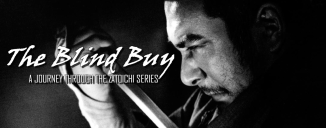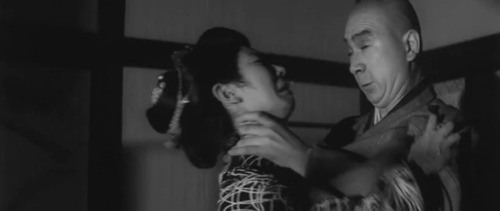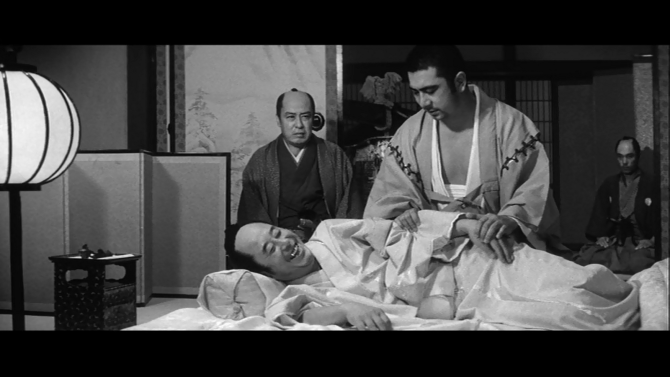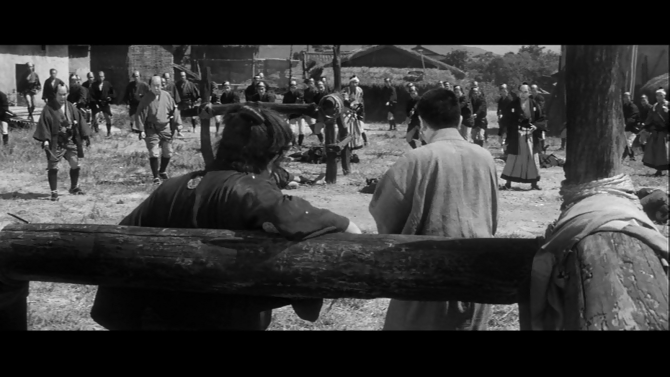THE BLIND BUY: A JOURNEY THROUGH THE ZATOICHI SERIES
by Kenneth Kimbrough
PART II – The Tale of Zatoichi Continues
Welcome back to the second edition of The Blind Buy, a semi-regular series in which I take on a film in the long-running Zatoichi franchise. This time, we take a look at the second film, The Tale of Zatoichi Continues. Since this film derives many of its plot points from the first, I highly recommend you read my write-up here if you haven’t already. Also, as in the last review, there are major spoilers. In this case, the third act spoiler completely alters the way the film is read. If you’re squeamish about that kind of thing, go watch the movie and then come back. I’ll wait.
One last thing—I neglected to mention the cover artist for the first film, which is rather uncool of me. That artist is Greg Ruth, and you can find more of his work, such as The Lost Boy, here. As for this entry’s artist, we have Paul Pope, creator of this year’s Battling Boy and other awesome comics. More of him here.
 Paul Pope’s box art for the film
Paul Pope’s box art for the film
When The Tale of Zatoichi was released, Daiei Film had a sleeper hit on their hands. Eager to capitalize on this success, they released The Tale of Zatoichi Continues (1962). Much like From Russia with Love, this film feels more in line with the later tropes of the series with its tighter plotting and bigger action. There’s also a bit of a story here when it comes to the film’s director, Kazuo Mori. This actually wasn’t the first film he directed about a blind conman. And furthermore, it wasn’t even the first film he directed with the series’ star, Shintaro Katsu. That dubious honor goes to Blind Menace (1960), which is something of an oddity. In it, Katsu plays yet another blind masseur, but this time, he murders, steals, and rapes without a second thought. It’s about as problematic a B-movie as it can get, and thankfully there weren’t any more of them made. But without that film, it’s said that there would be no Zatoichi. So thanks, I guess?
Our film was scored by Ichiro Saito, who’s mostly known for scoring other jidaigeki (period dramas). I preferred Ifukube’s score in the last film, as I felt it was more subdued in places. As for the film’s presentation, this is the final black and white entry in the series. And although I prefer my chanbara films this way, I won’t shed too many tears over the change. With all that said, on to The Tale of Zatoichi Continues!
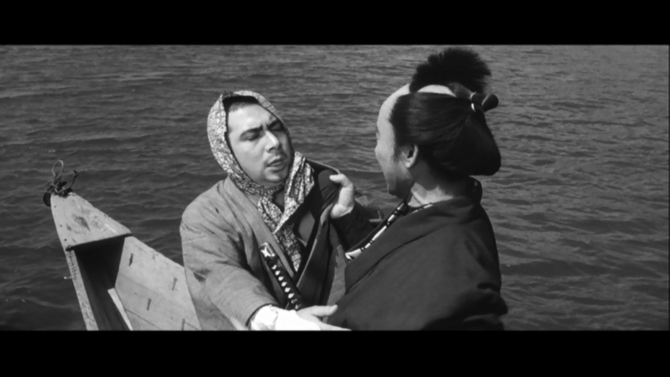 Zatoichi woken from his sleep.
Zatoichi woken from his sleep.
The film opens with a group of villagers in a boat as they ready to cross a river. From their clothing, we can easily see that they’re peasants. As they wait, a man approaches and demands to use the boat for his companions and himself. It’s very likely that these men are yakuza, as they all carry swords and threaten anyone who doesn’t listen. Acquiescing, the villagers leave and give the yakuza their way, which is our first indication of one of the central themes of this film—the exploitation and abuse of the lower classes by corrupt men with swords. And just as the film introduces this concern, it gives us the solution just as quickly. For hidden in the bow is the sleeping blind swordsman, Zatoichi.
On discovering our protagonist, the yakuza command him to get out. Ichi of course responds with his trademark irreverence, asking “Are we there?” Enraged, the group’s leader throws him out of the boat, but as he turns back to the camera, a thin dark line appears on his face, the line of blood that shows where Zatoichi has cut him after stealing the man’s own sword. And that brings us to theme number two—Zatoichi’s lightning swordsmanship.
On the other side of the river, the yakuza mull over their encounter with the swordsman—most likely surprised that they’re not all dead themselves. Word has spread of Ichi’s battle with Hirate in the previous film, and the rumor is that Ichi won the gang war all by himself. Yet the gang still feels slighted, so they decide to overpower him with their numbers.
When we cut to Ichi, we see him sprawled along the beach, sunbathing and letting his clothes dry. A second later, the camera cuts to a pair of sandals, slowly approaching the masseur. But these sandals don’t belong to the slighted yakuza. They belong to a one-armed samurai named Yoshiro (we won’t learn his name until later in the film), who is portrayed by none other than Lone Wolf himself, Tomisaburo Wakayama, real-life older brother to Shintaro Katsu.
Yoshiro observes Ichi but is interrupted by the yakuza as they rush in to overtake the blind swordsman. They draw their swords and Yoshiro draws his. Visibly shaken by the sight of a samurai, the yakuza encircle him, only to be cut down by the savage and powerful swipes of the stranger’s sword. There’s something to be said about Yoshiro’s fighting style. Whereas Zatoichi is very calculated in each move, executing each swing with finesse, Yoshiro is relentless and intimidating, his face curled in a snarl instead of the standard stoicism of other samurai. Yoshiro is an animal when he fights and he provides an interesting challenge for Ichi, both visually and narratively.
Once Yoshiro has dispatched of the yakuza, his partner springs out and cuts a wallet from one of the gangsters’ necks. Yoshiro nods with tacit approval, and the two return to where Ichi was basking, only to find the blind swordsman gone.
After this scene, we actually move on the event that will incite the main thrust of the film. As Ichi wanders through a nearby town, a man approaches him with a job offer. But as the details of the job emerge, Ichi becomes suspicious, especially when he discovers that his client is a daimyo. What makes this odd is that daimyo normally have a masseur as part of their retinue. Zatoichi, on the other hand, is a traveling masseur. Think of this as the difference between a $40 massage and a $400 massage.
When Ichi begins to massage his client, the daimyo begins to giggle, removing Ichi’s gloves (Ichi is too unclean to touch a daimyo with his bare hands) and playfully slapping at the masseur and poking at him. As this happens, the camera pans back and forth on the lord’s stewards, both of whom appear to be concerned, or at the very least embarrassed.
After the job, Ichi seeks out an inn for the night. But on his way, he meets three samurai on the road. Cautious, he asks them if there’s something they need. Remaining silent, one of the samurai draws his sword. Hearing this, Zatoichi takes his stance, warning them that drawing a sword is dangerous: “Just because your master is crazy doesn’t mean his retainers have to act like madmen too.” Without warning, one of the samurai lunges, but Ichi is too fast for him, and he incapacitates the man with his cane. This leads to one of my favorite lines of the film. When one of the samurai exclaims, “You’re no ordinary masseur,” Zatoichi coolly responds, “If I were, I would be dead.” He defeats the two remaining men with two quick strikes.
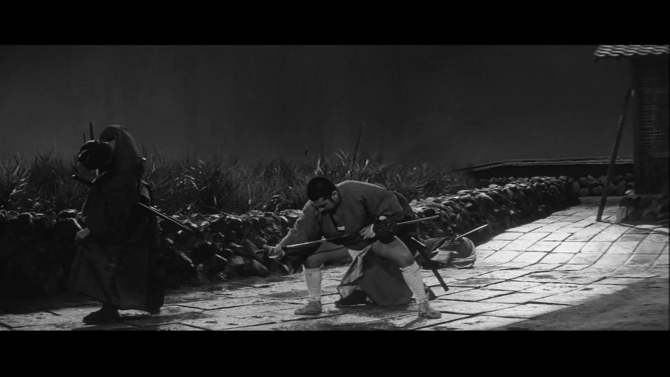 Things go about the way you’d expect.
Things go about the way you’d expect.
Before we continue, I feel it’s best to stop and talk about the film’s plot, which at first glance is somewhat convoluted. The reason Zatoichi is attacked on the road is because the daimyo he had massaged has a mental disability. As we discussed last time, the class structure in this period of Japan is very militaristic. However, military rule in this period is also hereditary. And if word spreads of the daimyo’s disability, his power could be challenged by a rival clan. Consequently, a military defeat would reduce all of the samurai in his service to ronin. As such, the stewards must keep their master’s condition a secret, which is why they pull Zatoichi off the road instead of hiring a masseur for their retinue. Because Ichi is in the lowest class, a nobody in their eyes, they have no qualms about assassinating him to keep their secret and to secure their reputation.
Returning to the film, the samurai, which we find out are the Kuroda clan, begin searching every inn for Ichi. We cut to a different inn where three prostitutes stop for a drink and discuss the search for the blind masseur. Of course, this is also the inn where that very same masseur is staying, and Zatoichi buys the women’s drinks to thank them for the information. This introduces us to the film’s brief love interest, Osetsu—played by Yaeko Mizutani—who offers to hide Ichi for the evening, along with her other services.
But just as he’s about to agree, one of the women tells them a samurai is approaching. However, this samurai isn’t one of the Kuroda clan’s retainers. It’s none other than Yoshiro and his partner.
Seeing their marks, the prostitutes approach the two men. But Yoshiro only has eyes for Osetsu, who bears an uncanny resemblance to the woman he once loved, Ochiyo. She declines, however, telling the samurai that she already has a customer. Not to be denied, Yoshiro tells her that he won’t see another man leave with her, which is when Ichi chimes in from his hiding place.
On hearing the name Ochiyo, Ichi asks to feel Osetsu’s face, and on doing so concludes that she does indeed resemble a woman that he too once loved, a woman also named Ochiyo. And recounting the tale to Osetsu, Ichi tells of how the woman he loved ran off with another man when she found out he was blind. In a fit of passion, Ichi went after the other man with his sword. Hearing this, Yoshiro withdraws to his table. Ichi and Osetsu leave for the night.
 The woman who looks like Ochiyo
The woman who looks like Ochiyo
We can skip around somewhat now that we’ve covered the main elements of the story. The only information that’s important to know is that the Kuroda clan hire the local yakuza, led by Boss Kanbei, to kill Zatoichi as he journeys to Joshoji temple, where the samurai Hirate rests. I’d like to point out here that the film suffers from sequel-itis for a large part of the second half, and we check in with characters superfluous to this particular film’s plot; Boss Sukegoro takes in Kanbei and his men, reminding us of the first film’s conflict; and Otane (now engaged to a carpenter) shows up to pine over Ichi again. I stress that these parts aren’t really needed because we’re retreading old ground. Otane has very little to do in this film and I would have liked to see more of Osetsu, who is far more interesting despite her brief screen time. Kanbei, on the other hand, is overshadowed by Sukegoro and never gets to develop into a villain in his own right. At the same time, this problem may stem from the fact that the sequel was rushed and the actors could very well have been still hanging around the Daiei lot after the first film.
As for actual developments, our visit to Sukegoro reveals a secret about Yoshiro. He’s not a samurai at all—he’s a yakuza and he and his partner are wanted criminals for robbery. The disguise is merely a ploy to evade police, who have put a sizable reward on the men’s heads. Never one to pass on a financial opportunity, Sukegoro secretly has a yakuza tail the robbers, and Yoshiro, like Zatoichi, becomes a man pursued.
Those points behind us, we can move on to Joshoji temple, the location of the film’s climax. While Ichi pays his respects to Hirate at the temple, Kanbei and Sukegoro march on the temple grounds. But before they can ambush him, Otane warns the blind masseur. The yakuza surround him, and he requests that the battle not take place on temple grounds. So they agree to fight him a short distance away. For the first time in the franchise, we get to see Ichi’s skills on a large scale. Yakuza after yakuza swarm him, but none are quick enough to dodge his blade. That is, until Yoshiro shows up.
 Kanbei’s goons surround Zatoichi
Kanbei’s goons surround Zatoichi
Seeing Sukegoro’s men quickly closing in on them, Yoshiro tells his partner to run. He approaches the battle, and seeing that Kanbei is the only one left, offers to kill Zatoichi himself. Yoshiro approaches Zatoichi, and the two men ready for a duel. What ensues is a Spaghetti-Western style staredown (or are those chanbara-style staredowns?) as the men wait for the other to make the first move. And suddenly, it begins. Yoshiro strikes relentlessly at Zatoichi, and for the first time, we see our protagonist desperate in his attempts to defend his own life. In this battle, Zatoichi is clumsy, swinging wildly. This is a battle of endurance more than it is skill. Backed against a wooden structure, Ichi manages to hamstring his foe, who in turn cuts Ichi’s sword arm. Both men clearly wounded, they pause as Ichi delivers the film’s final twist. If you intend to watch this film for the first time, do it now. You cannot watch the film the same afterwards.
Zatoichi addresses Yoshiro using familiar terms because Yoshiro is his older brother, whom Ichi crippled in the fight over the love of the two men’s lives, Ochiyo. Given this information, our entire reading of the film changes (and the casting of Katsu’s real-life brother makes more sense). The parallels between Ichi and Yoshiro were already strong at the beginning of the film. Ichi, lacks sight but possesses exceptional skill; Yoshiro lacks his left arm but possesses tremendous endurance and power. These two men are linked not only visually, through their disabilities and their appearance—they’re linked by blood, the blood that yearned for their Ochiyo, and the blood spilled in their ensuing conflict. This is how you reveal familial ties in a villain. This is how you show conflict.
This scene is intensified when Yoshiro proclaims that Ochiyo is dead and that it was he who killed her. In a frenzy, the two men struggle in hand-to-hand combat, twisting each other’s arms to prevent a fatal strike until finally Yoshiro slumps over a wooden beam, impaled on Zatoichi’s sword. Yet, miraculously, Ichi’s brother still lives. And the two men watch as Sukegoro’s men begin to surround them. But this isn’t the end—Zatoichi, his tenacity undying, still has some fight left in him, and he prepares to face the oncoming horde.
Undaunted, Ichi takes his brother and swings his sword, the yakuza shrinking back with every strike until Ichi jumps into the river, letting it carry the two to safety. The remaining scenes of the film depict Ichi and his brother in hiding as Yoshiro’s life slips away. Ichi nurses him in his dying moments, and reflects on the fact that two tragedies have now occurred when he’s been involved with Sukegoro—first Hirate and now Yoshiro. And as Yoshiro slips away, he reveals with his dying breath that Ochiyo still lives and that she left him when he lost his arm. Ichi and Yoshiro share one final moment as they chuckle at the irony. When his brother finally passes, a look of anguish crosses Ichi’s face. The music swells, and a look or resolve appears on his countenance. He knows what he has to do.
In the final moments of the film, Sukegoro and Kanbei return to the place where Ichi and his brother made their escape, only to find none other than the blind swordsman himself waiting for them. Enraged, he lambasts the Sukegoro for his betrayal, blaming him for the death of now two of his friends. And to prevent any more loss at the hands of such a corrupt man, Zatoichi kills Sukegoro, Kanbei, and their men as the film cuts to the end title.
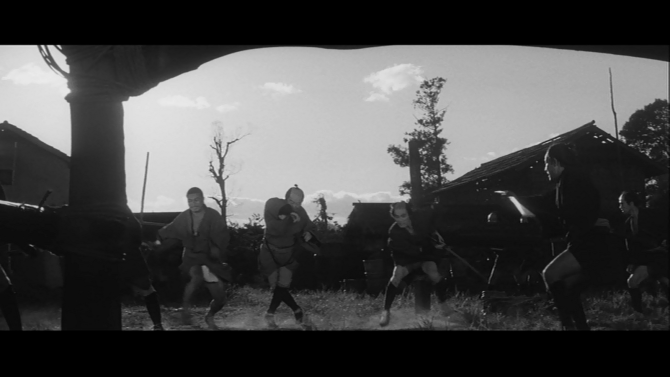 Justice at the hands of Zatoichi
Justice at the hands of Zatoichi
In a film full of pretensions—stewards pretending to have a powerful lord, robbers pretending to be samurai—the biggest is perhaps Ichi’s determination to be a good man. Time and again, he tries to stay out of trouble, but true to the chanbara formula, his skill as a swordsman precipitates his tragic circumstances, forcing him to kill to protect his own life or the lives of others. And in this film, the cost is his older brother.
As for closing thoughts, I rather enjoyed this film, but not as much as the first. There was far more action, and it was nice to finally see Zatoichi on equal footing with an opponent. However, the film’s second act suffered from poor structure and really hurt the pacing, which is inexcusable in a film that only runs a little over an hour. As always, thank you for reading. Until next time, don’t give massages to shady characters.
___________________________
Follow Kenneth Kimbrough on Twitter: @KKimbrough44

